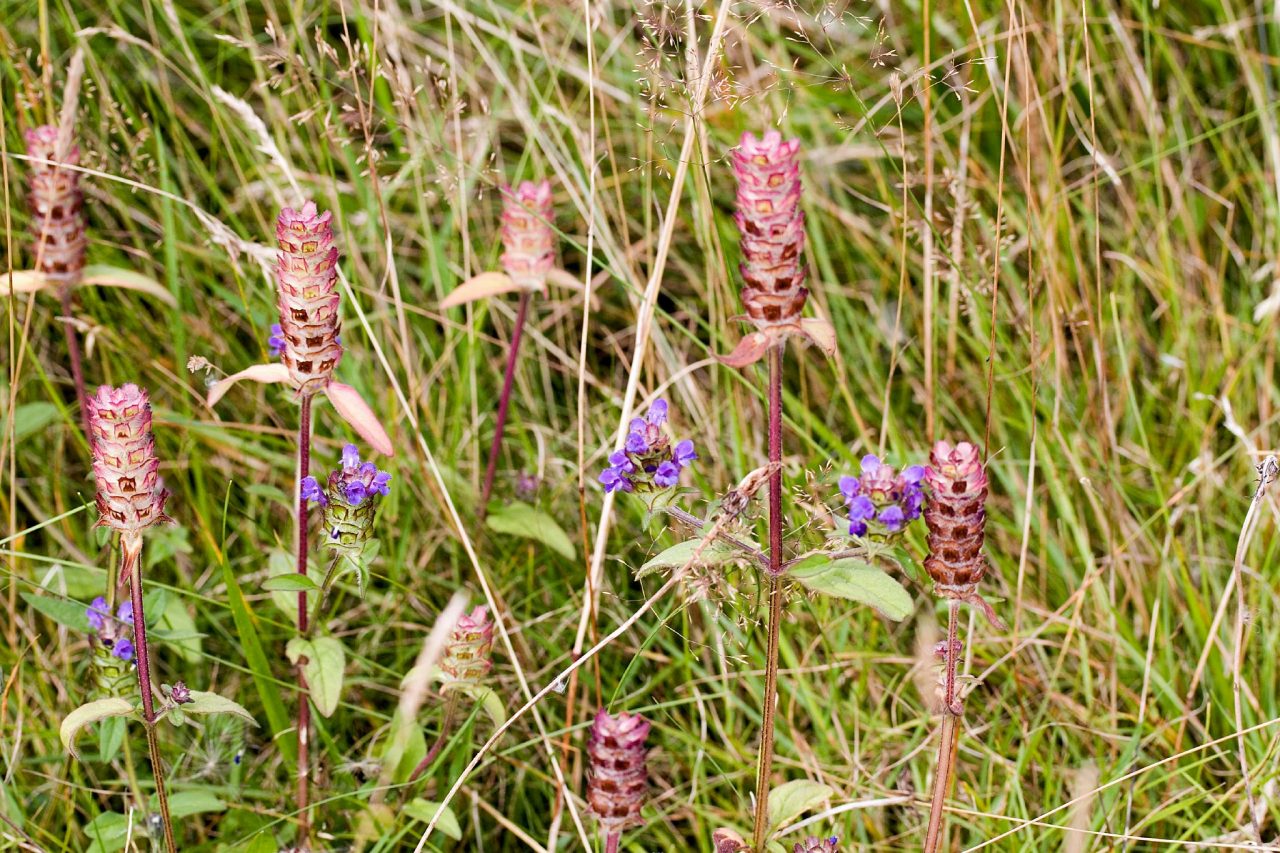Self-heal is a very versatile and safe herb that definitely deserves your attention. It’s one of the staples of traditional Chinese medicine and for a good reason. However, it doesn’t predominantly grow in Asia, chances are you could encounter this herb in Europe and North America as well. The flower spikes are mainly used to treat a variety of conditions in folk medicine.

Pinyin: Xia Ku Cao
Chinese: 夏枯草
Latin (plant): Prunella vulgaris/asiatica
Latin (part): Spica Prunellae
Part used: flower spike
Taste: pleasant, similar to old grass
Constituents: more than 200 constituents have been isolated, mostly triterpenoid saponins, sterols, flavonoids, coumarins, phenylpropanoids, monosaccharides, polysaccharides, tannins, volatile oils
Specific constituents: betulinic acid, D-camphor, delphinidin, hyperoside, oleanolic acid, rosmarinic acid, ursolic acid and its derivatives, ß-carotene, prunellin, sitosterol, stigmasterol, spinasterol, stigmast-7-en-3ß-ol, p-coumaric acid, tanshinone I, danshensu, gentisic acid, caffeic acid, rutin, quercetin, ferulic acid, chlorogenic acid, protecatechuic acid
Dosage: 10-15 g.
Feel free to use as much as you need as its toxicity is very low. I don’t recommend boiling it, so use hot water infusions. Cold water infusions may also be very beneficial due to the polysaccharide/saponin content that’s usually destroyed with heat. Alcoholic tinctures work just as well as water infusions, so I don’t see any reason to use them; it’s just a matter of convenience.
Potential benefits
Anti-inflammatory properties:
- inhibits MMP-9, NF-κB, (AP)-1
- reduces levels of ICAM-1, VCAM-1, E-selectin, ROS, downregulates NO production, suppresses MAPK, ERK
- COX-2 inhibitor
Anti-cancer properties:
- combats proliferation of T-lymphoma, Burkitt lymphoma, colon cancer → increases activity of p53 and ratio of Bax/Bcl-2; activates caspase 3 and 9; reduces mitochondrial membrane potential
- injections of self-heal have been proven to be stronger than chemotherapy/cisplatin when treating lung cancer
- lowers expression of VEGF-A and VEGFR-2; lowers expression of VEGF-A in colon cancer cells, manifesting potent antiangiogenic properties
- cytotoxic towards colon cancer, cervical cancer, liver cancer, lung cancer and stomach cancer
- inhibits growth of sarcoma
- potentiates anticancer drugs
- suppresses migration and invasiveness of liver cancer
- several of the polysaccharides have anticancer effects → polysaccharide P32 is active against lung cancer and has immunomodulatory effects, improves spleen and thymus indices; polysaccharide PVP is active against liver cancer, stomach cancer, breast cancer
- polysaccharides protect against cancer, inhibit secretion of bFGF and reduce density of microvessels in tumours
- causes apoptosis of thyroid cancer cells
- vulgarisin B and C are effective against lung cancer
- antineoplastic properties are mostly attributes to polysaccharides, ursolic acid and its derivatives, rosmarinic acid
- regulates environment of tumour metastases
- ursolic acid is effective against colon cancer, lung cancer and ovarian cancer
Antioxidant properties:
- anti-aging properties → reduces MMP-1, elastase, increases secretion of collagen (significant effects on wrinkles)
- polysaccharide PP2 protects membrane lipids against peroxidation and suppresses erythrocyte hemolysis
Hepatoprotective properties:
- potent against liver fibrosis →decreases elevated ALT, AST, procollagen type 3, hyaluronic acid, IL-4, IL-8, TNF-α, PDGF; regulates TGF-ß1, expression of actin, Smad2; inhibits activation of stellate cells, improves collagenolysis
Antibacterial properties:
- effective against: S. typhi, Vibrio cholerae, E. coli, Proteus vulgaris, S. aureus, Mycobacterium tuberculosis, P. aeruginosa, Salmonella typhimurium, Klebsiella pneumoniae, some fungal pathogens
Antiviral properties:
- effective against HSV-1, HIV, EIAV; lentiviruses (penetrates cells easily)
- most likely hinders adhesion of HIV virus onto CD4 receptor, might be beneficial as a preventative measure or in the case of acute exposure
Antidiabetic properties:
- reduces serum urea, sugar and creatinin
- suppresses diabetic inflammation of kidneys and kidney fibrosis → increases Smad; suppresses TGF-ß, Smad2/4, GTGF, collagen IV, biomarkers of fibrosis, ICAM-1, MCP-1; suitable for treating glomerulonephritis and glomerulosclerosis
- protects ß-cells of pancreas, fights type 1 diabetes
Neuroprotective properties:
- improves deficits caused by scopolamine
- improves cognitive processes →regulates GSK-3ß, Akt, ERK in brain cortex and hippocampus
- improves behavior in cases similar to schizophrenia
Cardioprotective properties:
- reduces systolic and diastolic blood pressure
- stimulates expression of eNOS, beneficial for cardiovascular diseases
Chondroprotective properties:
- inhibits aggrecanase, thus protecting cartilage
Immunomodulatory properties:
- attributed to polysaccharides
Antiallergenic properties:
- inhibits degranulation of mast cells
- decreases histamine levels
Photoprotective properties:
- protects dermal fibroblasts from UV-B and UV-A radiation → modulates TNF-α, IL-6, procollagen type I, MMPs, c-Jun, c-Fos, p-ERK, p-JNK, Smad 7, Smad 2/3; mostly attributed to rosmarinic acid
Insecticidal properties:
- ethanol/methanol extracts have strong insecticidal properties, effective against several plant diseases and lentiviruses
Miscellaneous properties:
- may have potential antiestrogenic effects
- potentially applicable for treatment of hyperprolactinemia
- effective against herpetic keratitis
- combats stress through seemingly adaptogenic properties
References
To come later or upon request. I am in the process of transferring all my hand-written information into a digital form, so it might take a while.
Featured image by tom00la, available here.

Leave a Reply